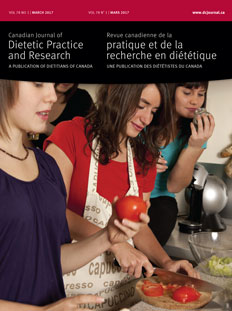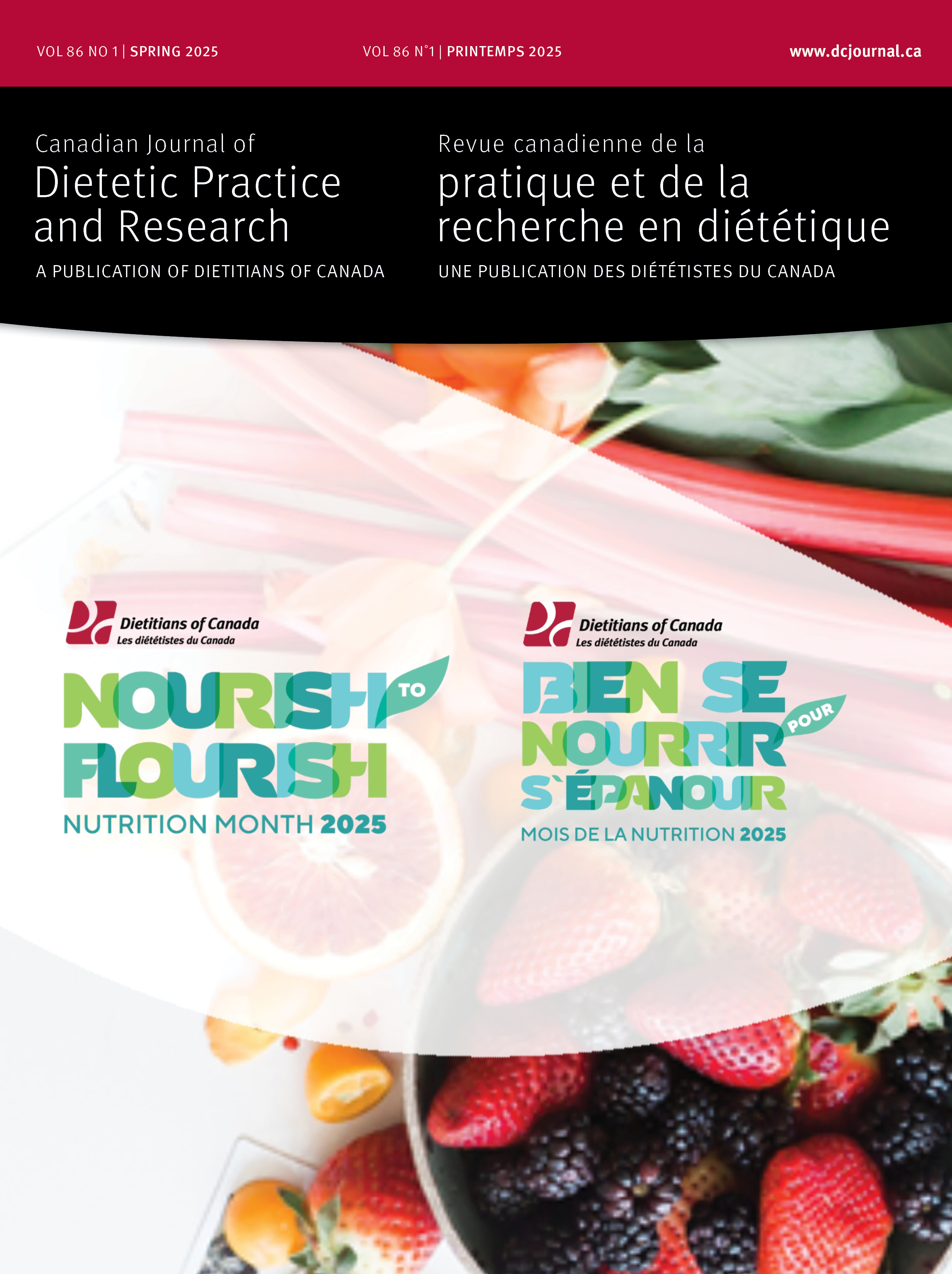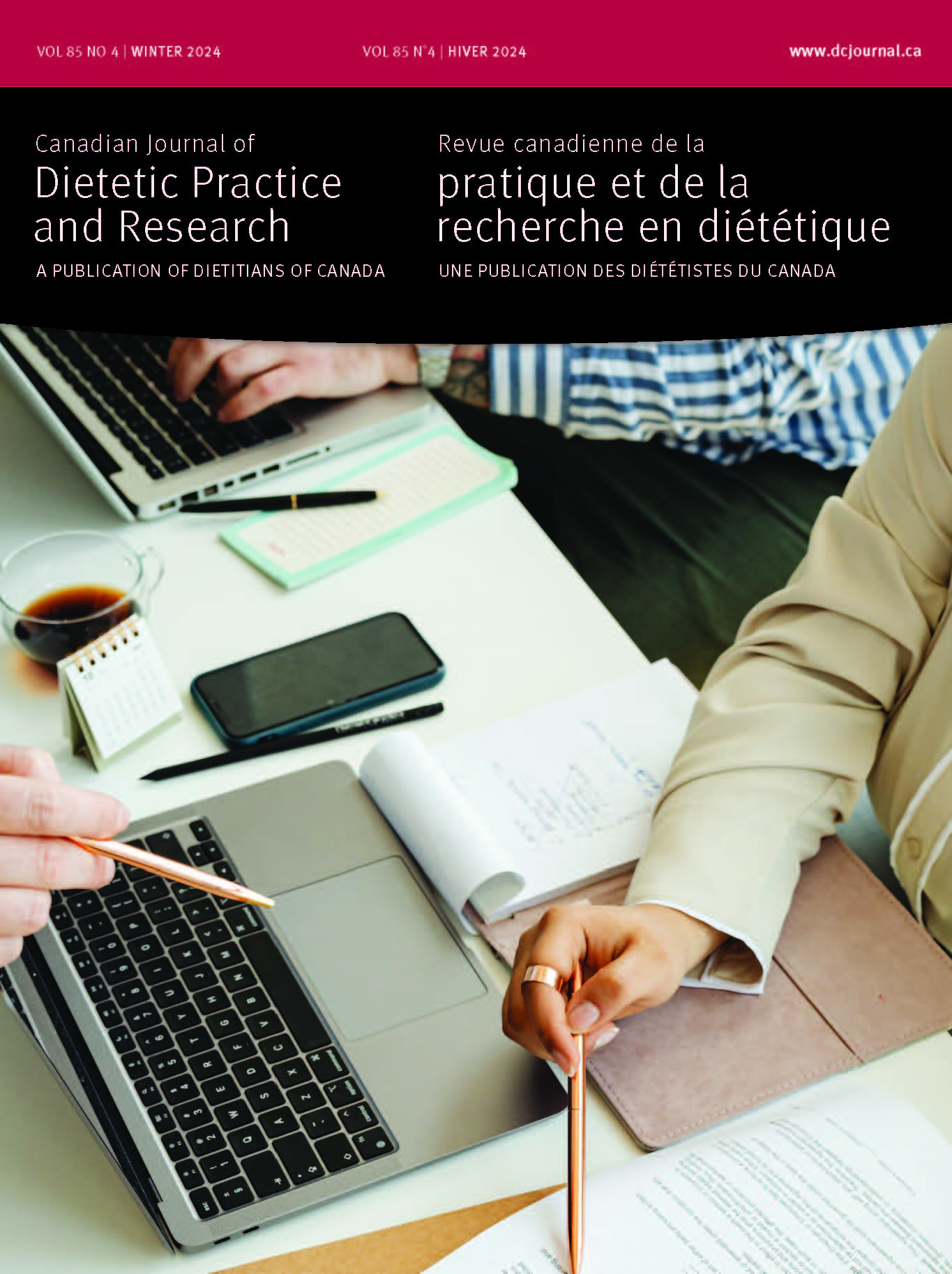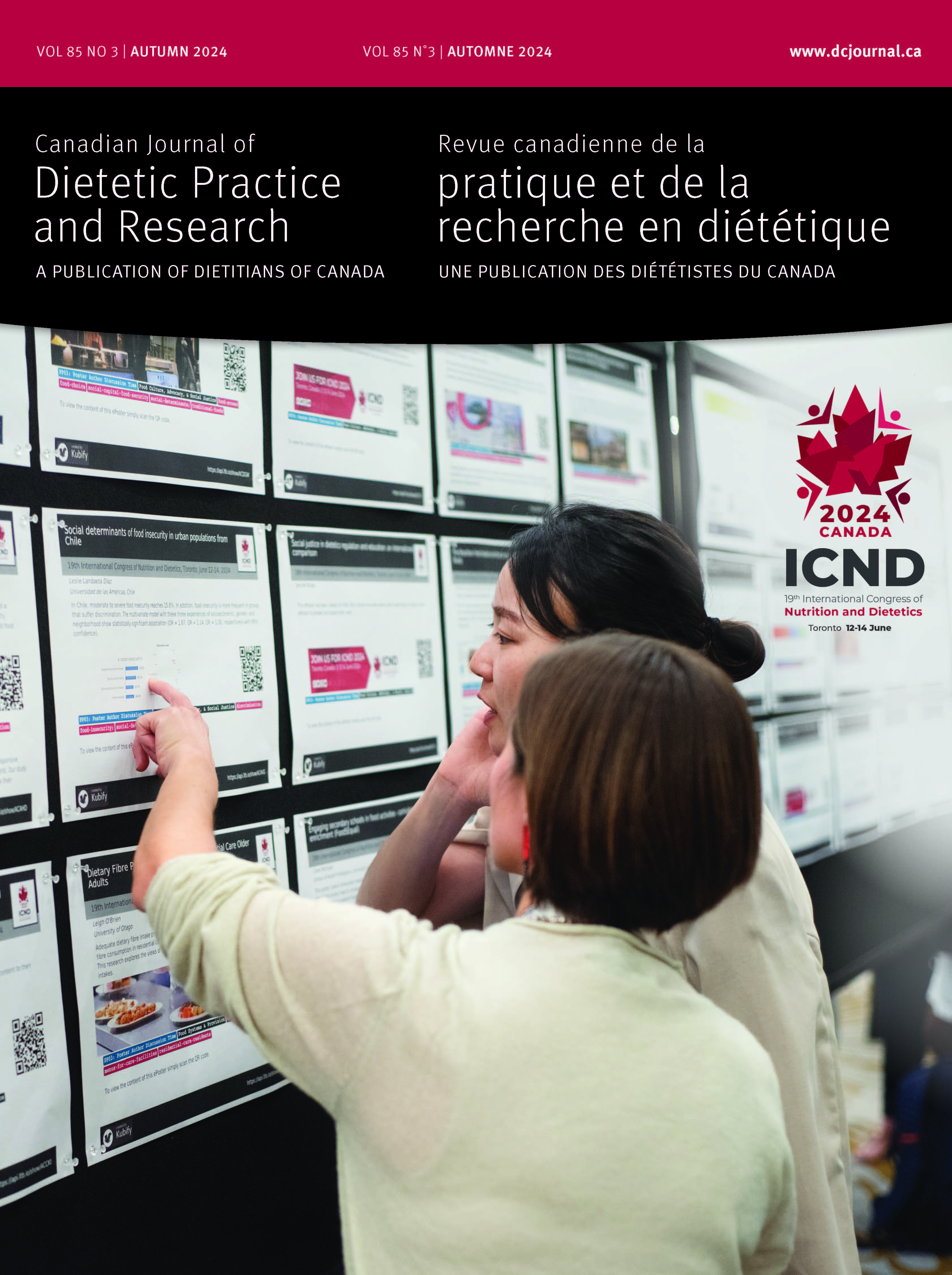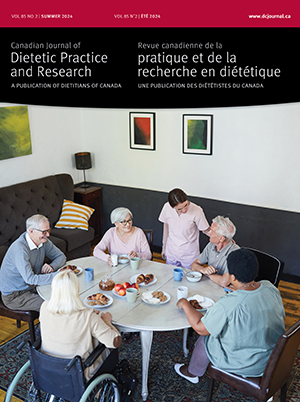Volume 78 • Number 1 • March 2017
Chair's Message
Editor's Message
Research
OPEN ACCESS
Purpose: To assess the type and quantity of foods children brought and consumed at school in the balanced school day (BSD), with two 20-minute eating periods, versus the traditional schedule (TS), with one 20-minute lunch.Methods: Direct observation identified food items and amounts in BSD and TS lunches of grade 3 and 4 students (n = 321).Results: The mean (SD) servings of foods packed in BSD lunches were significantly higher than the TS lunches for milk and alternatives (0.69 (0.70) vs 0.47 (0.49), P = 0.02), sugar-sweetened beverages (SSBs; 0.91 (1.24) vs 0.57 (0.99), P = 0.01), and snacks (2.74 (1.55) vs 2.24 (1.48), P < 0.01). Regardless of schedule, only 40.8% of students had vegetables packed in their lunch, whereas 92.8% had snacks. When comparing foods eaten, SSBs and snacks remained significantly higher in the BSD (0.75 (1.02) vs 0.48 (0.83), P = 0.03; 2.37 (1.44) vs 1.93 (1.36), P = 0.01, respectively). The proportion of children (%) whose consumption met one-third of Canada’s Food Guide recommendations for vegetables and fruit was low (27.5% BSD, 31.0% TS).Conclusions: The BSD may have unintended negative consequences on the type and amount of foods packed in school lunches. Support for families should focus on encouraging more vegetables and fruit and fewer SSBs and snacks in packed lunches.
Purpose: Patients with diabetes (DM) and chronic kidney disease (CKD) are at increased risk for suboptimal bone health. The study objective was to investigate the relationships between vitamin D (vitD), vitamin K1 (vitK1), and calcium intake with bone mineral density (BMD) and vitamin D status in an ambulatory population with DM and CKD.Methods: Adults (age 18–80 years; n = 62) with DM and CKD (stages 1–4) were recruited from the Northern Alberta Renal Program. Primary outcome variables included vitD, vitK1, and calcium intake; serum 25(OH)D, 1,25(OH)2D; and BMD as measured by dual X-ray absorptiometry. Statistical significance was determined at P < 0.05.Results: Participants met the estimated average requirement or adequate intake for vitD, vitK1, and calcium intake in 73% (n = 45), 66% (n = 39), and 52% (n = 31), respectively, with a combined intake of micronutrient supplementation and diet. Participants had serum 25(OH)D concentrations ≥75 nmol/L (n = 41), normal BMDs (n = 48), and 66% (n = 41/62) were taking vitD supplements (>1000 IU/D). BMD was positively influenced by serum 25(OH)D. However, serum 25(OH) ≥100 nmol/L was associated with lower BMD (absolute and T-scores) for whole-body and spine (P ≤ 0.05). VitK1 intake (≥200 μg/day) was associated with higher whole-body and femoral–neck BMDs (absoluteand T-scores; P ≤ 0.05).Conclusion: VitD status and BMD in adults with DM and CKD was influenced by vitD supplementation and vitK1 intake.
Purpose: The association between the energy density (ED) of foods and adiposity has been reported previously. However, whether the contribution of ED to adiposity remains significant when controlled for energy intake (EI) and physical activity energy expenditure (PAEE) remains to be clearly established. We aimed to investigate the independent contribution of ED to variations in body composition in women during the menopausal transition.Methods: Sixty-seven women from the MONET cohort study were analyzed. Seven-day food records were used to assess EI and ED. Body composition (body fat mass (FM) and trunk-fat mass (TFM)) was measured with dual-energy X-ray absorptiometry; PAEE was assessed with accelerometers. This secondary analysis of data included measurements obtained at years 1 and 5 of the study.Results: Mean ED was correlated with FM (r = 0.22; P = 0.04) and TFM (r = 0.22; P = 0.04) at year 1, but not at year 5. The multiple regression analysis showed that EI and ED contributed to 14% of the variance in FM and TFM at year 1.Conclusion: These results suggest that ED is a modest but inconsistent determinant of adiposity in healthy women at the time of the menopause transition.
Perspecitves in Practice
We examined self-care dietary practices and usual intakes among adults with Type 2 diabetes in Alberta, Canada, using data from the Healthy Eating and Active Living for Diabetes study. Participants completed a modified Fat/Sugar/Fruit/Vegetable Screener and answered questions about the number of days per week they followed specific diabetes self-care dietary recommendations. Capillary blood samples were collected to assess glycemic control measured by hemoglobin A1c (HbA1c). ANOVA was used to examine differences in dietary self-care, intakes, and glycemic control across categories of days/week of practicing recommended dietary behaviour. Participants (n = 196) were 51% women, mean ± SD age 59.6 ± 8.5 years, with BMI 33.6 ± 6.5 kg/m2, and diabetes duration of 5.1 ± 6.3 years. Sixteen percent of participants were unfamiliar with low-GI eating and 28% did not include low-GI foods in their diet. Overall, lower mean intake of saturated fat, trans fat, added sugars, higher fibre, and greater GI were each associated with meeting diabetes-related dietary behaviours including: eating ≥5 servings of vegetables and fruit; avoiding processed high fat foods; and replacing high with low-GI foods (P < 0.05). No clear pattern was observed for low-GI eating and HbA1c.
During a Dietitians of Canada conference session (2015), 4 facilitators drew upon “Alice’s Adventures in Wonderland” (Alice) to engage participants in discussing the future of dietetic education. The aim was to feature Nova Scotia (NS) collaborative experiences as an example of dietetic education planning that could be implemented elsewhere. Three vignettes from the Alice story were chosen as metaphoric representations of dilemmas and assumptions commonly faced by dietetic educators. Story quotations and facilitator questions related to each vignette-guided discussion. The 3-part story-based arts approach of hearing stories, recognizing stories, and telling stories enabled participants to reflect on their own practice, relate to the challenges of others, and question conventional wisdom. Participants heard the Alice stories, recognized their experiences through the NS examples and had an opportunity to tell their own stories during discussions. Participants identified barriers to and strategies for collaborative planning in their own regions. Evaluation suggests most participants were positively engaged by the storytelling approach. Participants recommended that future offerings allow more time for orientation and for completion of planned activities. Bilingual programming should also be considered. Participants valued the unconventional approach to workshop engagement and planned to implement it in their own workplaces.
A quasi-experimental study was conducted to evaluate the influence of Project CHEF, a hands-on cooking and tasting program offered in Vancouver public schools, on students’ food preferences, cooking skills, and confidence. Grade 4 and 5 students in an intervention group (n = 68) and a comparison group (n = 32) completed a survey at baseline and 2 to 3 weeks later. Students who participated in Project CHEF reported an increased familiarity and preference for the foods introduced through the program. This was statistically significant (P ≤ 0.05) for broccoli, swiss chard, carrots, and quinoa. A higher percentage of students exposed to Project CHEF reported a statistically significant increase (P ≤ 0.05) in: cutting vegetables and fruit (97% vs 81%), measuring ingredients (67% vs 44%), using a knife (94% vs 82%), and making a balanced meal on their own (69% vs 34%). They also reported a statistically significant increase (P ≤ 0.05) in confidence making the recipes introduced in the program: fruit salad (85% vs 81%), minestrone soup (25% vs 10%), and vegetable tofu stir fry (39% vs 26%). Involving students in hands-on cooking and tasting programs can increase their preferences for unpopular or unfamiliar foods and provide them with the skills and cooking confidence they need to prepare balanced meals.
Report
Purpose: The objective of the current study was to examine food and culinary skills and knowledge of dietetic students.Methods: An online bilingual survey was created using Survey MonkeyTM to explore the skills, knowledge, and perceptions of undergraduate dietetic students regarding food and cooking. Chi-square and logistic regression analyses were used to compare skills and knowledge of food and culinary concepts.Results: The final sample included second- (n = 22) and third-year (n = 22) students within the Baccalauréat specialisé en sciences de la nutrition program at the University of Ottawa. There were no significant differences (P > 0.05) on 3 of 4 skills (preparing a cake, whipping egg whites, or baking a yeast bread) or knowledge concepts (fold, baste, braise, grill, and poach) amongst second- and third-year students. Third-year students perceived more skill in preparing a béchamel sauce. There was a trend for third-year students (59%) to have higher food and cooking skills and knowledge compared with second-year students (32%).Conclusions: Perceived knowledge and confidence was proportional with the academic year, whereas overall knowledge and skills of food and culinary concepts were moderate among both groups of students. This research suggests that more dedicated time may need to be spent on food and cooking competencies in undergraduate dietetic education.
Objectif : L’objectif de cette étude était d’évaluer l’effet d’une offre d’aliments à textures adaptées (Épikura©) sur les apports nutritionnels et le poids de résidents âgés demeurant en centre d’hébergement et présentant une dysphagie.Méthodes : Un essai clinique randomisé avec groupe témoin d’une durée de 24 semaines a été réalisé auprès de résidents dysphagiques de trois centres d’hébergement. Le groupe expérimental a reçu les aliments Épikura© (dîner et souper) et le groupe témoin, les aliments à textures adaptées institutionnels. Les apports nutritionnels de deux jours consécutifs ainsi que le poids des participants ont été mesurés au début de l’étude, puis après 10 et 20 semaines. L’insu n’était pas possible.Résultats : Parmi les 27 participants recrutés (expérimental, n = 14; témoin, n = 13), huit sont décédés et deux ont été retirés. Après 20 semaines d’intervention, les personnes nourries avec les aliments Épikura© (n = 7) ont augmenté leurs apports énergétiques (P = 0,004), glucidiques (P = 0,04) et lipidiques (P = 0,001), comparativement au groupe témoin (n = 10). Il n’y a pas eu de changement significatif en regard du poids.Conclusions : La présente étude suggère que les aliments Épikura© permettent d’augmenter les apports énergétiques et nutritionnels et pourraient prévenir la dénutrition. D’autres études de plus grande envergure sont nécessaires.


